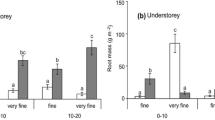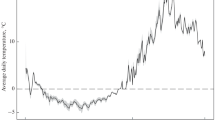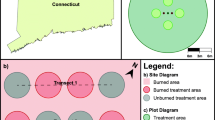Abstract
Wildfire is the principal disturbance regime in northern Boreal forests, where it has important rejuvenating effects on soil properties and encourages tree seedling regeneration and growth. One possible agent of this rejuvenation is fire-produced charcoal, which adsorbs secondary metabolites such as humus phenolics produced by ericaceous vegetation in the absence of fire, which retard nutrient cycling and tree seedling growth. We investigated short-term ecological effects of charcoal on the Boreal forest plant-soil system in a glasshouse experiment by planting seedlings of Betula pendula and Pinus sylvestris in each of three humus substrates with and without charcoal, and with and without phenol-rich Vaccinium myrtillus litter. These three substrates were from: (1) a high-productivity site with herbaceous ground vegetation; (2) a site of intermediate productivity dominated by ericaceous ground vegetation; and (3) an unproductive site dominated by Cladina spp. Growth of B. pendula was stimulated by charcoal addition and retarded by litter addition in the ericaceous substrate (but not in the other two), presumably because of the high levels of phenolics present in that substrate. Growth of P. sylvestris, which was less sensitive to substrate origin than was B. pendula, was unresponsive to charcoal. Charcoal addition enhanced seedling shoot to root ratios of both tree species, but again only for the ericaceous substrate. This response is indicative of greater N uptake and greater efficiency of nutrient uptake (and presumably less binding of nutrients by phenolics) in the presence of charcoal. These effects were especially pronounced for B. pendula, which took up 6.22 times more nitrogen when charcoal was added. Charcoal had no effect on the competitive balance between B. pendula and P. sylvestris, probably due to the low intensity of competition present. Juvenile mosses and ferns growing in the pots were extremely responsive to charcoal for all sites; fern prothalli were entirely absent in the ericaceous substrate unless charcoal was also present. Charcoal stimulated active soil microbial biomass in some instances, and also exerted significant although idiosyncratic effects on decomposition of the added litter. Our results provide clear evidence that immediately after wildfire fresh charcoal can have important effects in Boreal forest ecosystems dominated by ericaceous dwarf shrubs, and this is likely to provide a major contribution to the rejuvenating effects of wildfire on forest ecosystems.
Similar content being viewed by others
Author information
Authors and Affiliations
Additional information
Received: 23 May 1997 / Accepted: 24 February 1998
Rights and permissions
About this article
Cite this article
Wardle, D., Zackrisson, O. & Nilsson, MC. The charcoal effect in Boreal forests: mechanisms and ecological consequences. Oecologia 115, 419–426 (1998). https://doi.org/10.1007/s004420050536
Issue Date:
DOI: https://doi.org/10.1007/s004420050536




